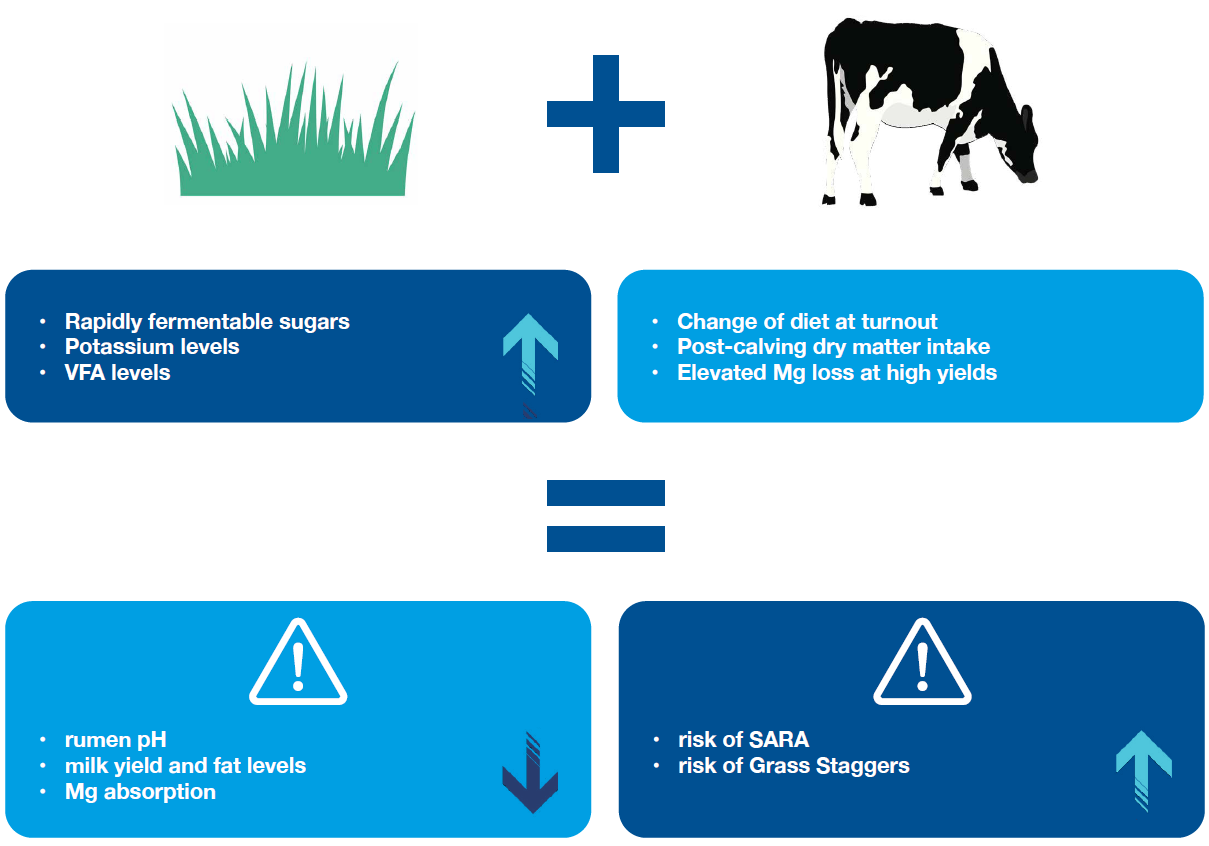Low magnesium status and sub-optimal rumen pH can be no stranger at spring turnout. At Wynnstay we believe the dual functionality of pHix-up, can be harnessed to both safeguard rumen health and enhance magnesium supply at grass.
Introducing pHix-up
pHix-up is a new addition to the Wynnstay portfolio and works as a persistent rumen buffer as well as a highly soluble source of magnesium (Mg). pHix-up is a blend of highly soluble sources of Magnesium Oxide (MgO), which can be applied as a top dress on buffer feed or available in blends.
Read more: How to prevent grass tetany using a magnesium supplement
Challenges faced at spring grass
Lush fast-growing pasture, in spring, can often be a cocktail of rapidly degradable protein and low fibre, and highly fermentable sugars1. These sugars, coupled with insufficient NDF, when transitioning to grazing + concentrates, from an indoor TMR system, can result in an upsurge of Volatile Fatty Acids (VFAs) (2). VFA’s promote the proliferation of rumen papillae and therefore fermentation activity, lowering rumen pH and risk of sub-acute rumen acidosis (SARA) (2).
Spring grass can have elevated potassium ion (K+) levels, which can be due to fertiliser application1,2,3. As K+ concentrations increase, intraluminal absorption of Mg ions (Mg2+) into the blood plasma will linearly fall, as K+ disrupt Mg2+active transport, across the rumen wall (1). If unchecked, hypomagnesemia (low blood Mg), can result in a drop in feed intake and milk production (3,4). Severe hypomagnesemia causes misfiring of the nervous system causing muscle tremors, which is what we classically come across as grass tetany or grass staggers (3,4).


Use of magnesium oxide in diets
Increasing the dietary supply of Mg can overcome any potential staggers risk, as at a higher concentration, Mg2+ can passively diffuse across the rumen wall, without K+ interference (3,4).
We would generally recommend 60g of MgO to supply 30g/h/day Mg. Mg can be easily supplied in the diet by MgO, commonly known as ‘Cal Mag’, both in and out of the parlour, a minimum of two weeks before the risk grazing period (5).
MgO is also a common rumen buffer to alleviate the risk of SARA, either on its own or with sodium bicarbonate (6).
MgO can only be efficacious when solubilised to Mg2+ in the rumen, allowing for greater bioavailability for the cow. Solubility of the product can depend on:
- Timing and Temperature of the Calcining process
- Particle size (7)
There can be inconsistency across different MgO products with solubility ranging from 40-70%, making it challenging to know the best choice (5).
Unique buffer with the bonus of Mg
pHix-up is specifically designed from combined sources of MgO to work as a unique buffer agent, 96% sustained >6 hours in the rumen8. The neutralising capacity of pHix-up is up to three-fold higher than common buffer materials (Table 1) meaning more acid can be neutralised at the same dose (9). pHix-up has an Mg solubility of >85%, providing a consistent source of Mg, when most vital (8).
pHix up is recommended to be fed at 50 to 125g/h/day (8) though will be highly dependent on your own individual system and mineral supply. Please contact your local Wynnstay representative, for more information on the best way to use pHix-up for your herd.
Table 1: Comparison of the neutralising capacity of typical buffers with pHix up
| Buffer Source | Neutralising Capacity (meq/g) | Ratio to pHix-up |
| Sodium Bicarbonate | 12 | 3.25:1 |
| Magnesium Oxide (standard) | 15 | 2.5:1 |
| pHix UP | 39 | 1 |
References:
1. Oberson J, Probst S, Schlegel P. Magnesium Absorption As Influenced By The Rumen Passage Kinetics In Lactating Dairy Cows Fed Modified Levels Of Fibre And Protein. Animal. 2019;13(7):1412-1420.
2. Hartwiger J, Schären M, Potthoff S, Hüther L, Kersten S, Von Soosten D Et Al. Effects Of A Change From An Indoor-Based Total Mixed Ration To A Rotational Pasture System Combined With A Moderate Concentrate Feed Supply On Rumen Fermentation Of Dairy Cows. Animals. 2018;8(11):205. 3. Mann S, Mcart J, Abuelo A. Production‐Related Metabolic Disorders Of Cattle: Ketosis, Milk Fever And Grass Staggers. In Practice. 2019;41(5):205-219. 4. Martens H, Leonhard-Marek S, Röntgen M, Stumpff F. Magnesium Homeostasis In Cattle: Absorption And Excretion. Nutrition Research Reviews. 2018;31(1):114-130. 5.Timab.2020a 6. Neville E, Fahey A, Gath V, Molloy B, Taylor S, Mulligan F. The Effect Of Calcareous Marine Algae, With Or Without Marine Magnesium Oxide, And Sodium Bicarbonate On Rumen Ph And Milk Production In Mid-Lactation Dairy Cows. Journal Of Dairy Science. 2019;102(9):8027-8039. 7.Timbab 2020b 8. Phix-Up - Timab Magnesium [Internet]. Timab Magnesium. 2022 [Cited 15 February 2022]. Available From: Https://Timabmagnesium.com/En/Magnesium-Based-Products/Agricultural-Applications/Animal-Nutrition-By-Timab-Magnesium/Specialty-Phix-Up/Timab 2020a 9.Timab 2021











